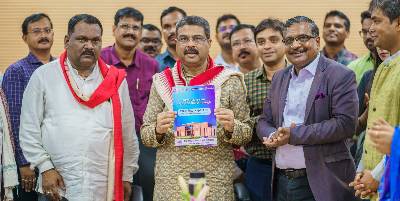- ●एस.बी.आई के बाद पी.एन.बी बना दूसरा बड़ा बैंक, सरकारी बैंकों की संख्या घट कर हुई १२
- ●केरल में लहराया पाकिस्तानी झंडा, ३० से ज्यादा छात्रों पर मुकदमा दर्ज
- ●यूपीएससी २०१९ मेन्स परीक्षा के एडमिट कार्ड जारी, ऐसे करें डाउनलोड
- ●हरतालिका तीज व्रत और पूजन तिथि
- ●अमृता प्रीतम की १००वीं जयंती आज
- ●बेरोजगारों के लिए योगी सरकार लगा रहीं रोजगार मेला
- ●महाराष्ट्र के एक केमिकल फैक्ट्री में आग, ८ लोगों की मौत
- ●असम : गृह मंत्रालय ने जारी की एन.आर.सी की फाइनल लिस्ट
The 10 Gurus of Sikhism
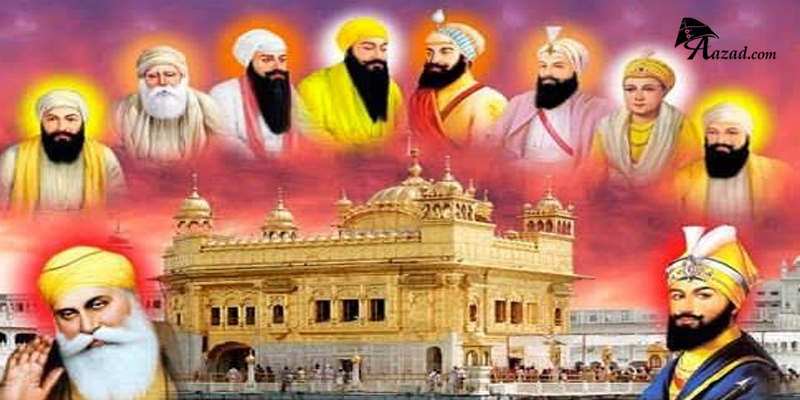
(1) Guru Nanak:
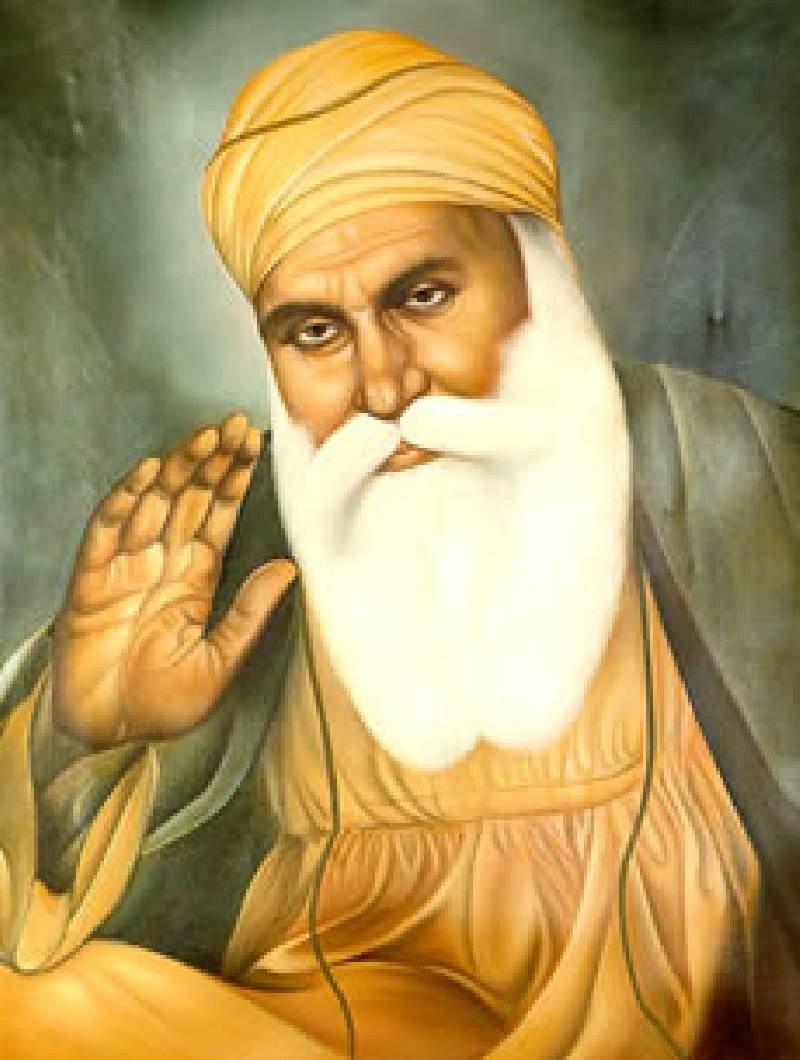 Guru Nanak Jayanti (15 April1469- 2 September1539) is the birthday of the First Sikh Guru, Guru Nanak, and one of the most sacred festivals in Sikhism. The word Jayanti means birthday in Hindi. Sikh Guru's birthdays are known as Gurpurab.
Guru Nanak Jayanti (15 April1469- 2 September1539) is the birthday of the First Sikh Guru, Guru Nanak, and one of the most sacred festivals in Sikhism. The word Jayanti means birthday in Hindi. Sikh Guru's birthdays are known as Gurpurab.
गुरु नानक जी के अनुयायी इन्हें गुरु नानक, गुरु नानक देव जी, बाबा नानक और नानकशाह नामों से संबोधित करते हैं। गुरु नानक दार्शनिक, योगी, गृहस्थ, धर्मसुधारक, समाजसुधारक, कवि, देशभक्त और विश्वबंधु - सभी के गुण समेटे हुए थे। नानक का जन्म रावी नदी के किनारे स्थित तलवंडी नामक गाँव में 15 अप्रैल, 1469 में कार्तिकी पूर्णिमा को एक खत्रीकुल में हुआ था। इनके पिता का नाम कल्यानचंद या मेहता कालू जी था, माता का नाम तृप्ता देवी था। इनकी बहन का नाम नानकी था। नानक बचपन से इनमें प्रखर बुद्धि के लक्षण दिखाई देने लगे थे। लड़कपन ही से ये सांसारिक विषयों से उदासीन रहा करते थे। पढ़ने लिखने में नानक का मन नहीं लगता था । ७-८ साल की उम्र में उनका स्कूल छूट गया तत्पश्चात् सारा समय वे आध्यात्मिक चिंतन और सत्संग में व्यतीत करने लगे। बचपन के समय में कई चमत्कारिक घटनाएं घटी जिन्हें देखकर गाँव के लोग इन्हें दिव्य ऴ्यक्तित्व मानने लगे।
नानक का विवाह सोलह वर्ष की अवस्था में गुरदासपुर जिले के अंतर्गत लाखौकी नामक स्थान के रहनेवाले मूला की कन्या सुलक्खनी से हुआ था। ३२ वर्ष की अवस्था में इनके प्रथम पुत्र श्रीचंद का जन्म हुआ। चार वर्ष पीछे दूसरे पुत्र लखमीदास का जन्म हुआ। दोनों लड़कों के जन्म के उपरांत १५०७ में नानक अपने परिवार का भार अपने श्वसुर पर छोड़कर मरदाना, लहना, बाला और रामदास इन चार साथियों को लेकर तीर्थयात्रा के लिये निकल पडे़।
जीवन के अंतिम दिनों में इनकी ख्याति बहुत बढ़ गई और इनके विचारों में भी परिवर्तन हुआ। स्वयं विरक्त होकर ये अपने परिवारवर्ग के साथ रहने लगे और दान पुण्य, भंडारा आदि करने लगे। उन्होंने करतारपुर नामक एक नगर बसाया, जो कि अब पाकिस्तान में है और एक बड़ी धर्मशाला उसमें बनवाई।
मृत्यु से पहले उन्होंने अपने शिष्य भाई लहना को अपना उत्तराधिकारी घोषित किया जो बाद में गुरु अंगद देव के नाम से जाने गए।
(2) Guru Angad Sahib:
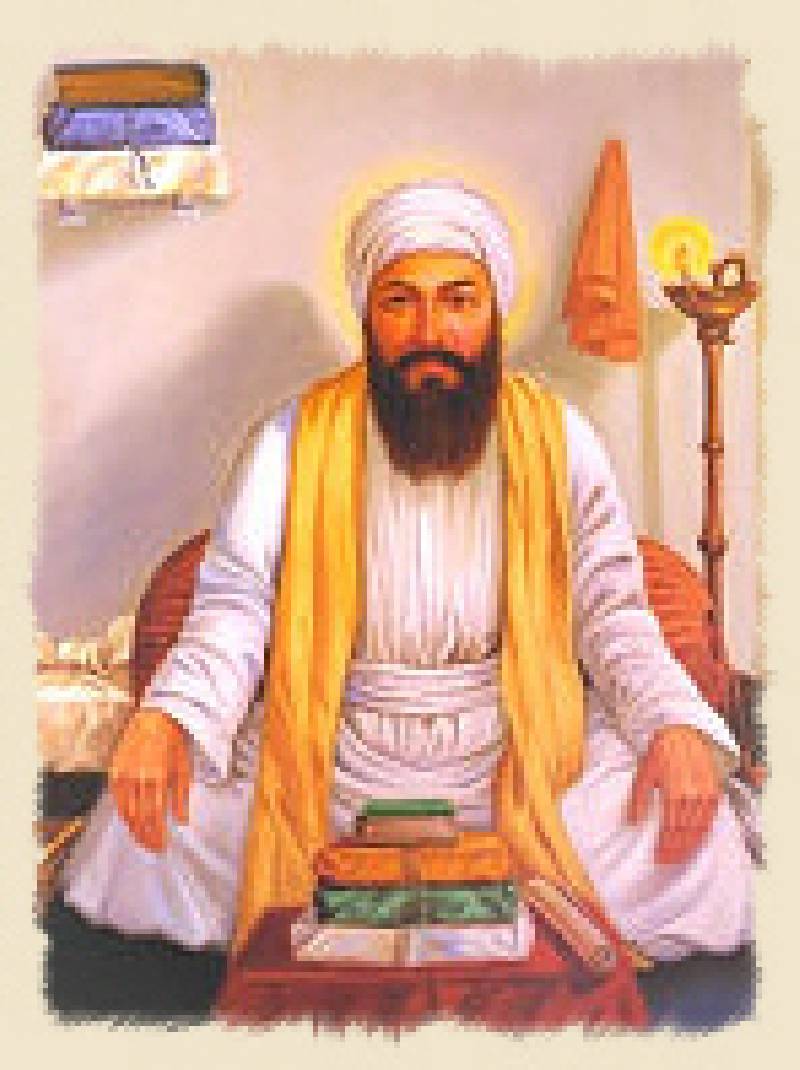 Guru Angad Sahib (31 March 1504- 28 March 1552) was the second of the ten Sikh Gurus. He was born in the village of Sarae Naga in Muktsar district in Punjab, on March 31 1504 and given the name Lehna shortly after his birth as was the custom of his Hindu parents. He was the son of a small successful trader named Pheru Mal. His mother's name was Mata Ramo(also known as Mata Sabhirai, Mansa Devi and Daya Kaur). Baba Narayan das Trehan was his grandfather, whose ancestral house was at Matte-di-Sarai near Mukatsar.
Guru Angad Sahib (31 March 1504- 28 March 1552) was the second of the ten Sikh Gurus. He was born in the village of Sarae Naga in Muktsar district in Punjab, on March 31 1504 and given the name Lehna shortly after his birth as was the custom of his Hindu parents. He was the son of a small successful trader named Pheru Mal. His mother's name was Mata Ramo(also known as Mata Sabhirai, Mansa Devi and Daya Kaur). Baba Narayan das Trehan was his grandfather, whose ancestral house was at Matte-di-Sarai near Mukatsar.
गुरु अंगद देव का पूर्व नाम लहना था। भाई लहणा जी के ऊपर सनातन मत का प्रभाव था, जिस के कारण वह देवी दुर्गा को एक स्त्री एंवम मूर्ती रूप में देवी मान कर, उसकी पूजा अर्चना करते थे। वो प्रतिवर्ष भक्तों के एक जत्थे का नेतृत्व कर ज्वालामुखी मंदिर जाया करता था। १५२० में उनका विवाह माता खीवीं जी से हुआ। उनसे उनके दो पुत्र - दासू जी एवं दातू जी तथा दो पुत्रियाँ - अमरो जी एवं अनोखी जी हुई।
मुगल एवं बलूच लुटेरों (जो कि बाबर के साथ आये थे) की वजह से फेरू जी को अपना पैतृक गांव छोड़ना पड़ा। इसके पश्चात उनका परिवार तरन तारन के समीप अमृतसर से लगभग २५ कि॰मी॰ दूर स्थित खडूर साहिब नामक गांव में बस गया, जो कि ब्यास नदी के किनारे स्थित था।सतगुरु नानक से भाई लहने ने आत्म ज्ञान लिया जिस ने उन्हें पूर्ण रूप से बदल दिया। वो सतगुर नानक साहिब की विचारधारा के सिख बन गये एवं करतारपुर में निवास करने लगे।
गुरू अंगद साहिब ने गुरु नानकदेव प्रदत्त पंजाबी लिपि के वर्णों में फेरबदल कर गुरूमुखी लिपि की एक वर्णमाला को प्रस्तुत किया। वह लिपि बहुत जल्द लोगों में लोकप्रिय हो गयी। उन्होने बच्चों की शिक्षा में विशेष रूचि ली। उन्होंने विद्यालय व साहित्य केन्द्रों की स्थापना की। नवयुवकों के लिए उन्होंने मल्ल-अखाड़ा की प्रथा शुरू की। जहां पर शारीरिक ही नहीं, अपितु आध्यात्मिक नैपुण्यता प्राप्त होती थी। गुरू अंगद साहिब जी ने गुरू नानक साहिब जी द्वारा स्थापित सभी महत्वपूर्ण स्थानों एवं केन्द्रों का दौरा किया एवं सिख धर्म के प्रवचन सुनाये। गुरू अंगद साहिब ने गुरू नानक साहिब द्वारा स्थापित परम्परा के अनुरूप अपनी मृत्यु से पहले अमर दास साहिब को गुरुपद प्रदान किया।
(3) Guru Amar Das:
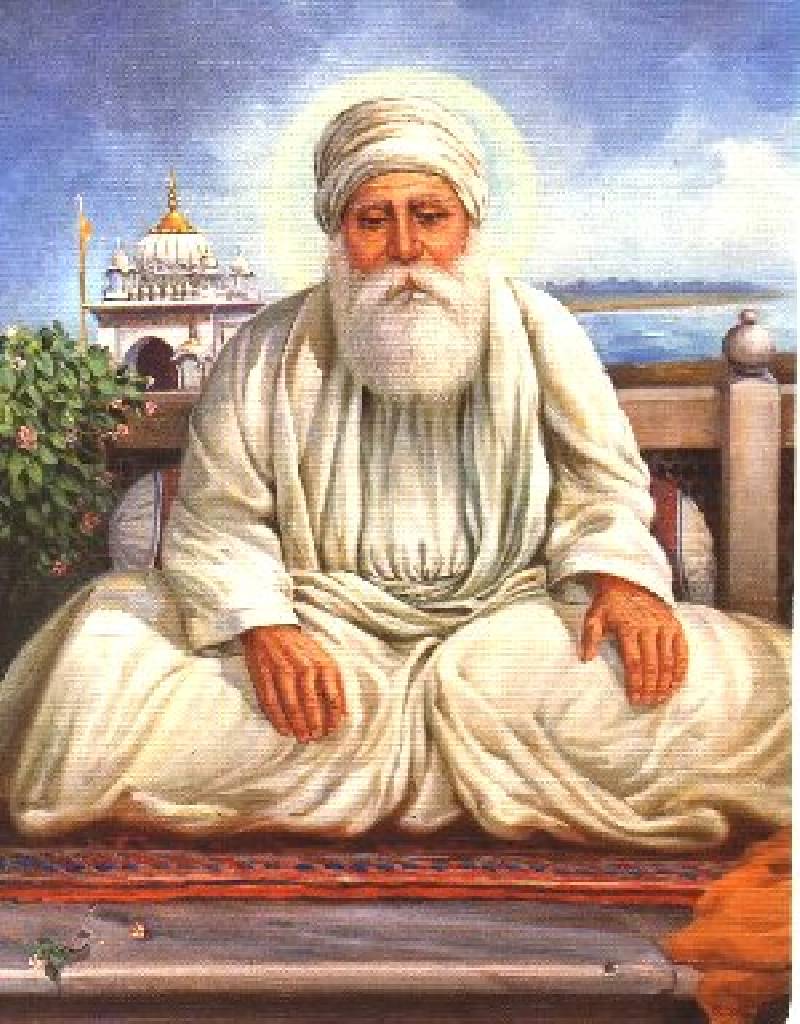 Guru Amar Das (5 May 1479 - 1 September 1574) was the third of the Ten Gurus of Sikhism and was given the title of Sikh Guru on 26 March 1552.
Guru Amar Das (5 May 1479 - 1 September 1574) was the third of the Ten Gurus of Sikhism and was given the title of Sikh Guru on 26 March 1552.
He was born to a midde class farmer and trader Tejbhan Bhalla and Bhakht Kaur. Born in a typical Vaishnava family, Amardas followed its traditional religious practices, and abstained from meat. He got married to Mansa Devi at the age of 24. He was religiously inclined and followed the Vaishnava mode of worship and used to visit Hardwar every year for Pilgrimage. Guru Amar Das fought against caste restrictions, caste prejudices and the curse of untouchability. He strengthened the tradition of the free kitchen, Guru Ka Langar (started by Guru Nanak), and made his disciples irrespective of their cast, creed, gender or financial status, have their meals together sitting in one place. Guru Amardas established social equality amongst the people.
(4) Guru Ram Das:
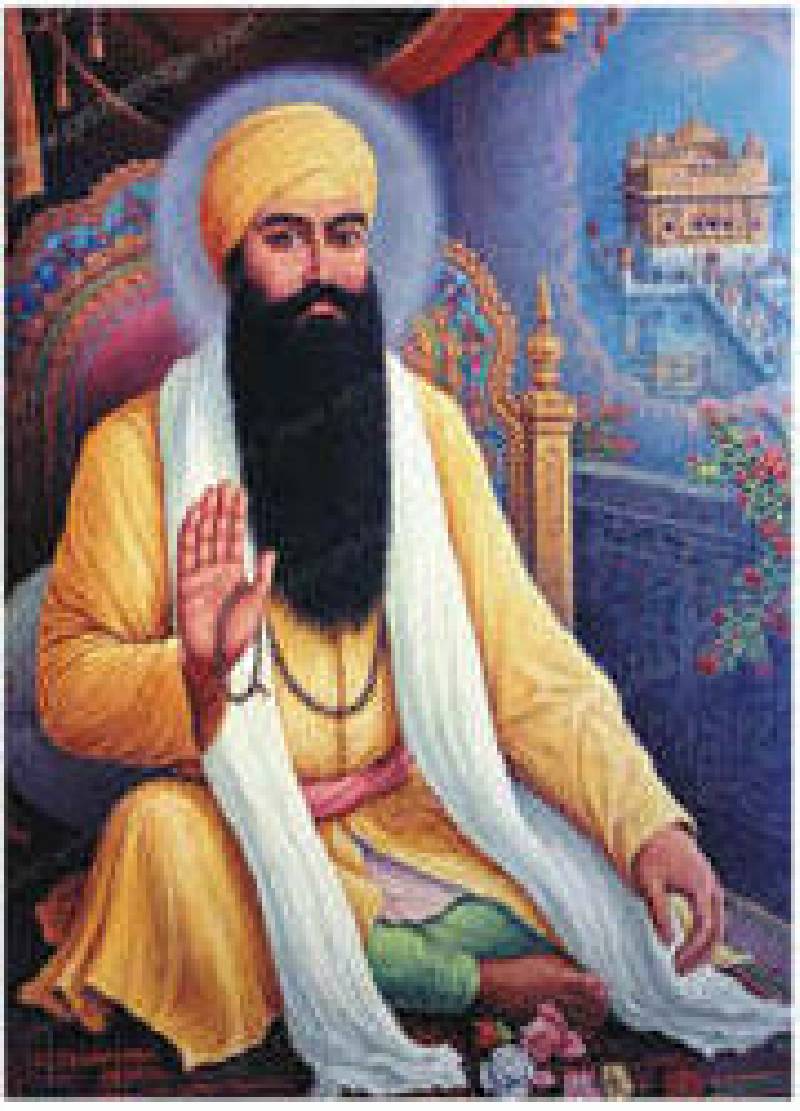 Guru Ram Das (1534-1581) was the Fourth of the Ten Gurus of Sikhism and was given the title of Sikh Guru on 30 August 1574.
Guru Ram Das (1534-1581) was the Fourth of the Ten Gurus of Sikhism and was given the title of Sikh Guru on 30 August 1574.
Like his predecessors, Guru Ram Das carried on the work of Langar in a more elaborate and methodical way. As in the past strict adherence was made to the term 'Pangat' in Langar. Guru Ram Das composed a hymn known as 'Lawan' in Suhi Mohalla 4, page 773 of Guru Granth Sahib, and asked his Sikhs to recite them to solemnize marriages. The Sabad 'Lawan' embodies in itself a lesson for the couple to develop true love for each other. In reality this Sabad is for a human being to develop love for the divine bridegroom.
(5) Guru Arjan Dev Ji:
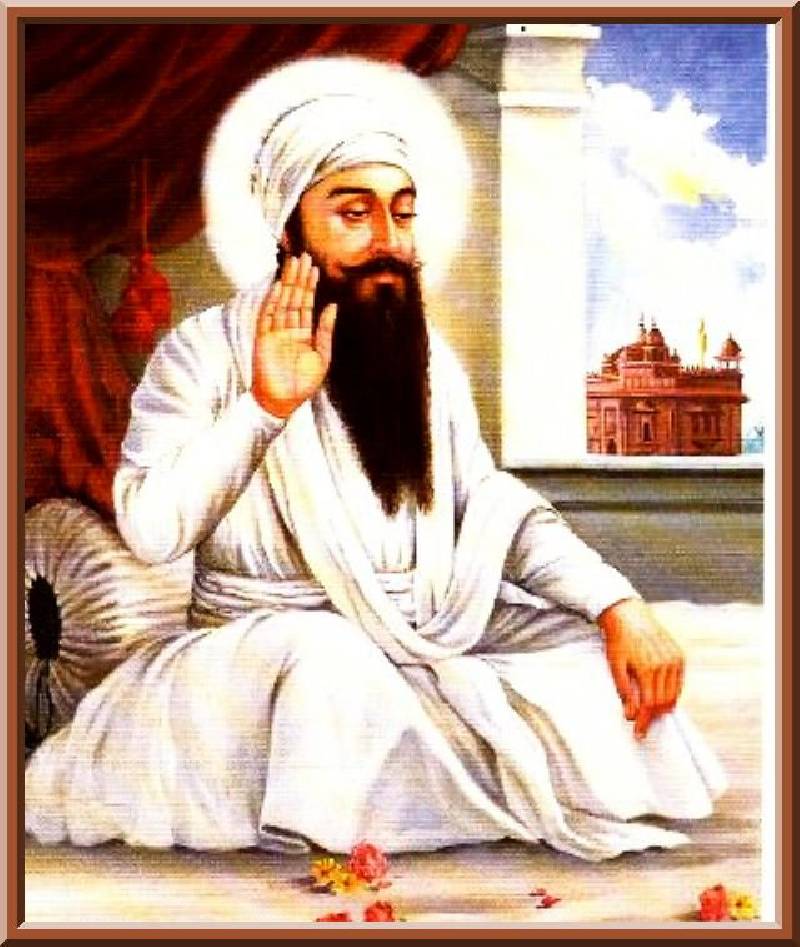 Guru Arjan Dev Ji (15 April 1563-30 May 1606) was the fifth of ten Gurus of Sikhism. He was born in Goindval, Punjab, India, the youngest son of Guru Ram Das and Bibi Bhani, the daughter of Guru Amar Das. He became the Guru of the Sikhs on 1 September 1581 after the death of his father Guru Ram Das. Guru Arjan died in Lahore, Punjab,( nowin Pakistan). Beforehis death, he nominated his son Har Gobin d as the next Guru of Sikhs.
Guru Arjan Dev Ji (15 April 1563-30 May 1606) was the fifth of ten Gurus of Sikhism. He was born in Goindval, Punjab, India, the youngest son of Guru Ram Das and Bibi Bhani, the daughter of Guru Amar Das. He became the Guru of the Sikhs on 1 September 1581 after the death of his father Guru Ram Das. Guru Arjan died in Lahore, Punjab,( nowin Pakistan). Beforehis death, he nominated his son Har Gobin d as the next Guru of Sikhs.
गुरु अमरदास जी ने अपने से पहले दो गुरुओं के उपदेशों और संगीतों को लोगों तक पहुंचाने का काम किया। “आनन्द साहिब” जिसे परमानन्द का गीत कहते हैं, का लेखन गुरु अमरदास जी ने ही किया था। उन्होंने अपने कार्यकाल के दौरान लंगरों के आयोजन को विशेष महत्व दिया। गुरु अमरदास जी ने जाति भेदभाव को खत्म करके अपने अनुयायियों के बीच सामाजिक सद्भावना के बीज बोए। गुरु अमरदास ने मंजी और पिरी जैसे धार्मिक कार्यों की शुरूआत की। उरु अमरदास जी का महिलाओं और पुरुषों की शिक्षा व्यवस्था पर भी विशेष जोर दिया था।
गुरु अमरदास साहिब ने ही बादशाह अकबर से कहकर सिखों और हिंदुओं को उनपर लगने वाले इस्लामिक जज़िया कर से निजात दिलवाई थी। गुरु अमरदास जी ने भारत में सती प्रथा का विरोध किया और विधवाओं के पुनर्विवाह करवाने का समर्थन भी किया। कई लोग का यह भी मानना हैं कि गुरु जी सती प्रथा के विरोध में आवाज उठाने वाले पहले समाज सुधारक थे। छुआछूत को समाप्त करने के लिए गुरु अमरदास जी ने 'सांझी बावली' का निर्माण भी कराया था ।
(6) Guru Hargobind Sahib:
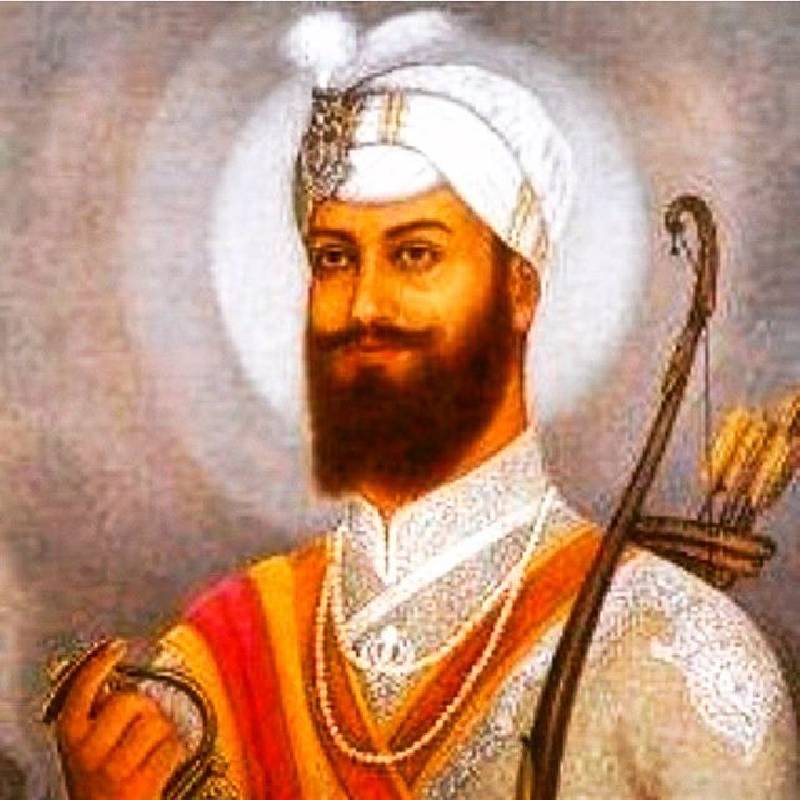 Guru Hargobind Sahib (19 June 1595 -2 March 1644) was the sixth Guru of the Ten Gurus of Sikhism and became Guru on 25 May 1606 following in the footsteps of his father Guru Arjan Dev. He was the six Guru in Sikhism. He was not, perhaps, more than elevan at his father's execution. Before ascension, he nominated Guru Har Rai, his grandson as the next Guru of the Sikhs.
Guru Hargobind Sahib (19 June 1595 -2 March 1644) was the sixth Guru of the Ten Gurus of Sikhism and became Guru on 25 May 1606 following in the footsteps of his father Guru Arjan Dev. He was the six Guru in Sikhism. He was not, perhaps, more than elevan at his father's execution. Before ascension, he nominated Guru Har Rai, his grandson as the next Guru of the Sikhs.
गुरु हरगोबिन्दसाहिब जी बहुत परोपकारी योद्धा थे। उनका जीवन दर्शन जन-साधारण के कल्याण से जुडा हुआ था। यही कारण है कि उनके समय में गुरमतिदर्शन राष्ट्र के कोने-कोने तक पहुंचा। श्री गुरु ग्रन्थ साहिब के महान संदेश ने गुरु-परम्परा के उन कार्यो को भी प्रकाशमान बनाया जिसके कारण भविष्य में मानवता का महा कल्याण होने जा रहा था। गुरु हरगोबिन्दसाहिब ने सिक्ख जीवन दर्शन को सम-सामयिक समस्याओं से केवल जोडा ही नहीं, बल्कि एक ऐसी जीवन दृष्टि का निर्माण भी किया जो गौरव पूर्ण समाधानों की संभावना को भी उजागर करता था। सिख लहर को प्रभावशाली बनाने में गुरु जी का महत्व योगदान रहा । गुरु ने सिक्ख धर्म, संस्कृति एवं इसकी आचार-संहिता में अनेक ऐसे परिवर्तनों को अपनी आंखों से देखा जिनके कारण सिक्खी का महान बूटा अपनी जडे मजबूत कर रहा था। विरासत के इस महान पौधे को गुरु हरगोबिन्द साहिब ने अपनी दिव्य-दृष्टि से सुरक्षा प्रदान की तथा उसे फलने-फूलने का अवसर भी दिया। अपने पिता श्री गुरु अर्जुन देव की शहीदी के आदर्श को उन्होंने न केवल अपने जीवन का उद्देश्य माना, बल्कि उनके द्वारा जो महान कार्य प्रारम्भ किए गए थे, उन्हें सफलता पूर्वक सम्पूर्ण करने के लिए आजीवन अपनी प्रतिबद्धता भी दिखलाई थी ।
(7) Guru Har Rai:
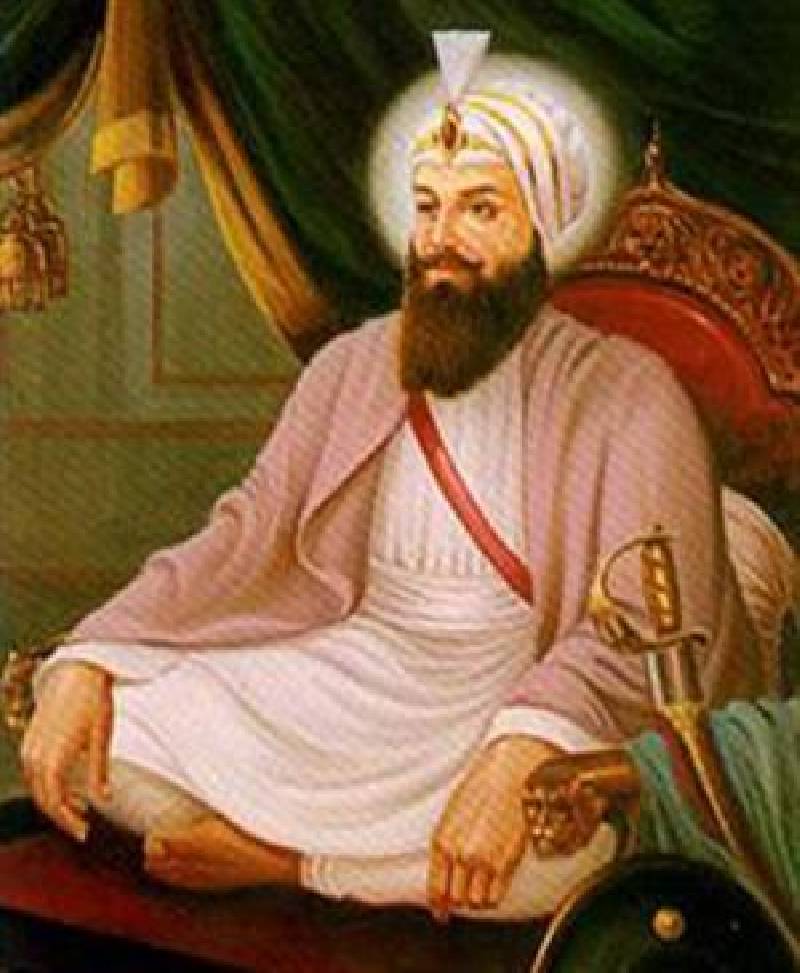 Guru Har Rai (26 February1630 - 6 October 1661) was the seventh of ten living Gurus of the Sikhs who became Guru on 8 March 1644 following in the footsteps of his grandfather, Guru Har Gobind, who was the sixth guru. Before he died, he nominated five years old Har Krishan, his youngest son as the next Guru of the Sikhs. The following is a summary of the main highlights of Guru Har Rai's Life.
Guru Har Rai (26 February1630 - 6 October 1661) was the seventh of ten living Gurus of the Sikhs who became Guru on 8 March 1644 following in the footsteps of his grandfather, Guru Har Gobind, who was the sixth guru. Before he died, he nominated five years old Har Krishan, his youngest son as the next Guru of the Sikhs. The following is a summary of the main highlights of Guru Har Rai's Life.
(8) Guru Harikrishan:
 Guru Harikrishan 23 July 1656- 30 March 1664 was the eighth of the Ten Gurus of Sikhism. He became Guru on 7 October 1661, succeeding his father, Guru Har Rai. After his death from smallpox, his granduncle, Guru Tegh Bahadur, became the next Guru of the Sikhs.
Guru Harikrishan 23 July 1656- 30 March 1664 was the eighth of the Ten Gurus of Sikhism. He became Guru on 7 October 1661, succeeding his father, Guru Har Rai. After his death from smallpox, his granduncle, Guru Tegh Bahadur, became the next Guru of the Sikhs.
(9) Guru Teg Bahadur:
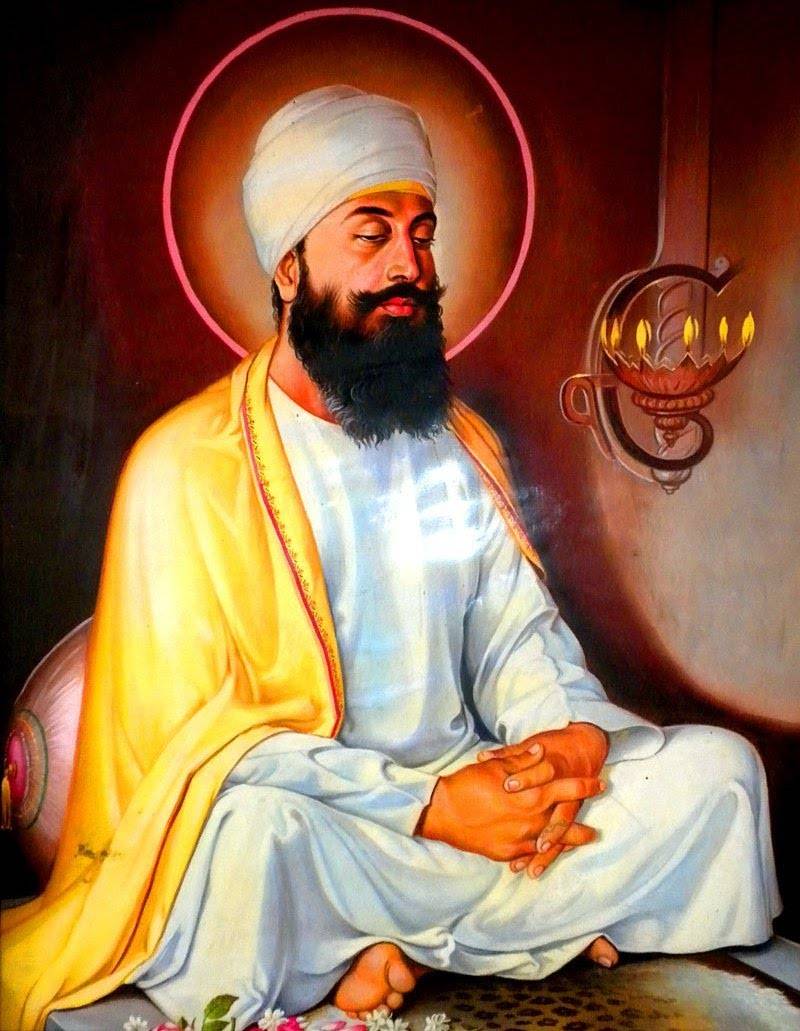 Guru Teg Bahadur(1 April 1621- 11 November 1675) became the 9thGuru of Sikhism on 20 March 1665, following. in the footsteps of his grand -nephew, Guru Har Krishan. Guru Teg Bahadur was executed on the orders of Mughal Emperor Aurangzeb in Delhi.
Guru Teg Bahadur(1 April 1621- 11 November 1675) became the 9thGuru of Sikhism on 20 March 1665, following. in the footsteps of his grand -nephew, Guru Har Krishan. Guru Teg Bahadur was executed on the orders of Mughal Emperor Aurangzeb in Delhi.
(10) Guru Gobind Singh:
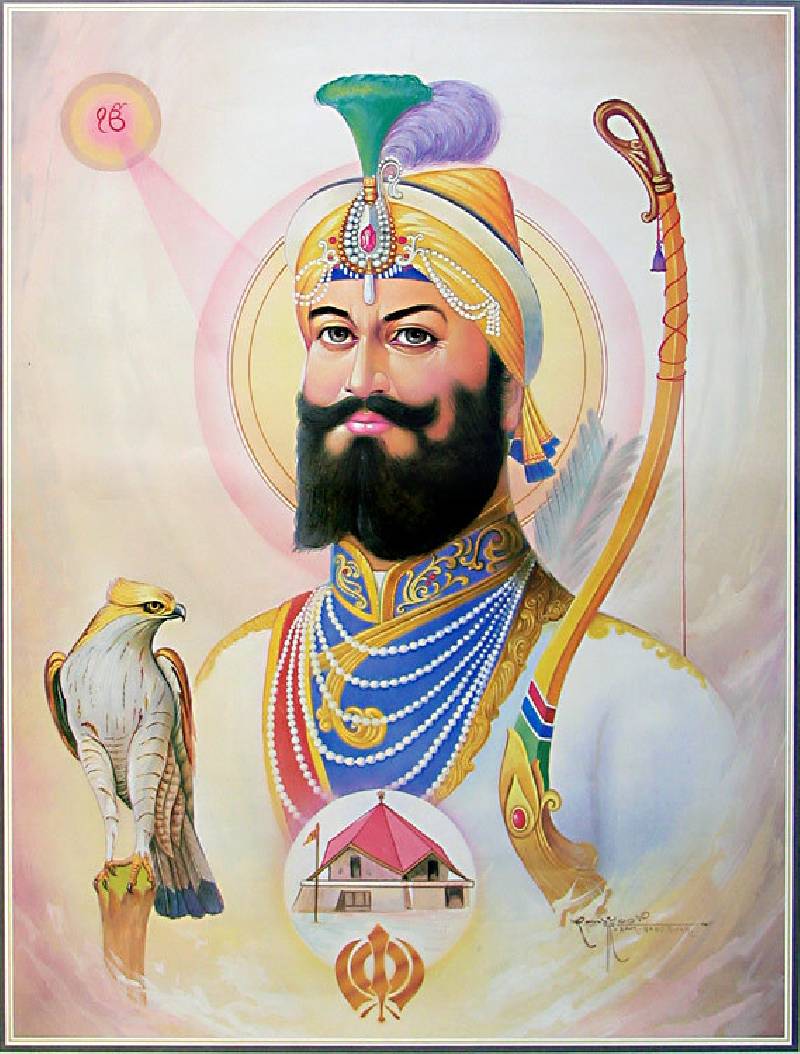 Guru Gobind Singh Born (22 December 1666 - 7 October 1708) was the last of ten Sikh gurus. Born in Patna, Bihar in India, he was also a warrior, poet and philosopher. He succeeded his father Guru Tegh Bahadur as the leader of Sikhs at a young age of nine. He introduced many customs to Sikhism but his most important contribution was the formalization of the religious sect of Sikhs into a full-fledged religion Khalsa (pure) in 1699. He is still seen as an epitome of chivalry, skilled in horsemanship and armed combat and generous in character among his followers.
Guru Gobind Singh Born (22 December 1666 - 7 October 1708) was the last of ten Sikh gurus. Born in Patna, Bihar in India, he was also a warrior, poet and philosopher. He succeeded his father Guru Tegh Bahadur as the leader of Sikhs at a young age of nine. He introduced many customs to Sikhism but his most important contribution was the formalization of the religious sect of Sikhs into a full-fledged religion Khalsa (pure) in 1699. He is still seen as an epitome of chivalry, skilled in horsemanship and armed combat and generous in character among his followers.

